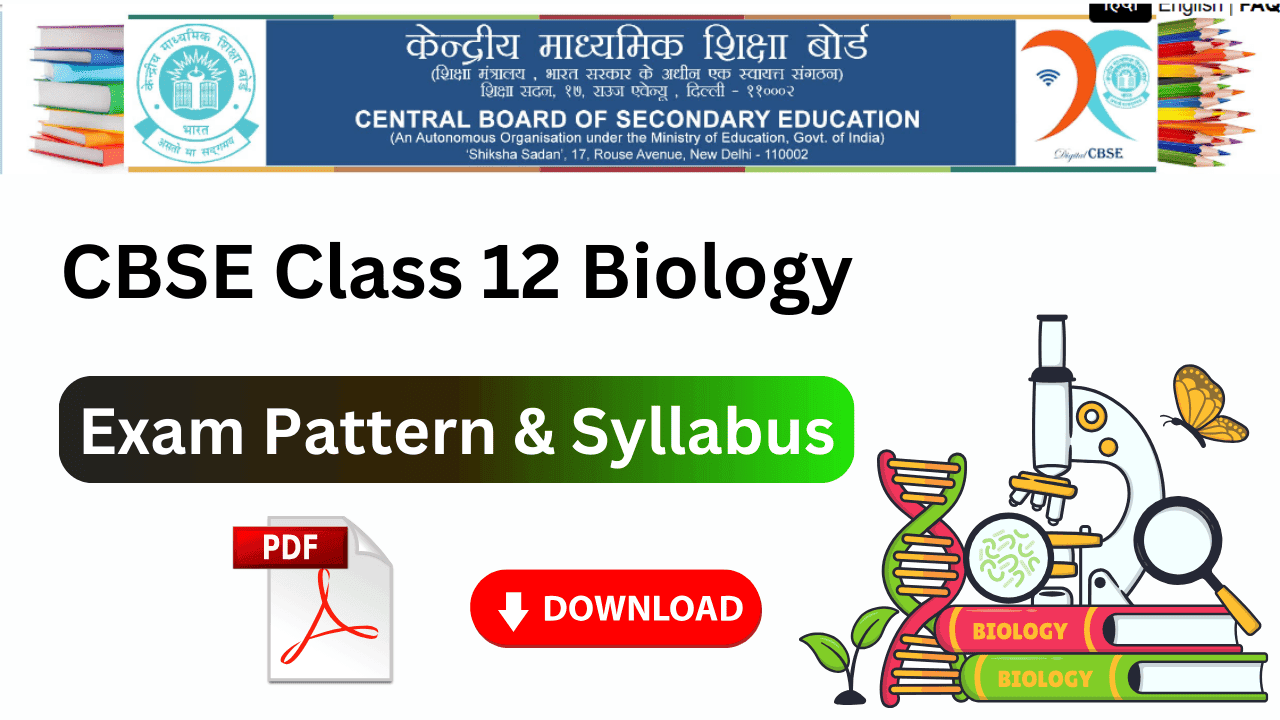Updated CBSE Class 12 Biology Syllabus for 2025-26 – Get the latest chapter-wise syllabus, marking scheme, and study tips. Download the official PDF at the end!
Overview of CBSE Class 12 Biology Syllabus 2025-26
The Class 12 CBSE syllabus for Biology plays a crucial role in board exams and competitive exams like JEE, NEET, CUET, etc. This year, CBSE has introduced competency-based questions and a revised weightage system to encourage conceptual learning over rote memorization.
| Board | CBSE |
| Class | 12 |
| Session | 2025-26 |
| Subject | Biology |
| Content-Type | Syllabus/Curriculum |
| Official Website | https://cbseacademic.nic.in |
COURSE STRUCTURE - CLASS XII BIOLOGY (2025-26)
Time: 3 Hours
Max. Marks: 70
| Unit | Title | Marks |
|---|---|---|
| VI | Reproduction | 16 |
| VII | Genetics and Evolution | 20 |
| VIII | Biology and Human Welfare | 12 |
| IX | Biotechnology and its Applications | 12 |
| X | Ecology and Environment | 10 |
| Total | 70 |
Unit-VI: Reproduction (16 Marks)
Chapter-1: Sexual Reproduction in Flowering Plants
- Flower structure
- Development of male and female gametophytes
- Pollination: Types, agencies, and examples
- Outbreeding devices
- Pollen-pistil interaction
- Double fertilization
- Post-fertilization events:
- Development of endosperm and embryo
- Formation of seed and fruit
- Special modes:
- Apomixis
- Parthenocarpy
- Polyembryony
- Significance of seed dispersal and fruit formation
Chapter-2: Human Reproduction
- Male and female reproductive systems
- Microscopic anatomy of testis and ovary
- Gametogenesis:
- Spermatogenesis
- Oogenesis
- Menstrual cycle
- Fertilization and embryo development (up to blastocyst)
- Implantation, pregnancy, and placenta formation (elementary idea)
- Parturition and lactation (elementary idea)
Chapter-3: Reproductive Health
- Need for reproductive health and prevention of STDs
- Birth control: Need, methods, and contraception
- Medical Termination of Pregnancy (MTP)
- Amniocentesis
- Infertility and assisted reproductive technologies (ART):
- IVF (In Vitro Fertilization)
- ZIFT (Zygote Intrafallopian Transfer)
- GIFT (Gamete Intrafallopian Transfer)
Unit-VII: Genetics and Evolution (20 Marks)
Chapter-4: Principles of Inheritance and Variation
- Heredity & Variation:
- Mendelian inheritance (Laws of Inheritance)
- Deviations from Mendelism:
- Incomplete dominance (e.g., Snapdragon flowers)
- Co-dominance (e.g., Blood groups ABO)
- Multiple alleles (e.g., ABO blood system)
- Pleiotropy (e.g., Phenylketonuria)
- Polygenic inheritance (e.g., Skin color, height)
- Chromosome theory of inheritance (Sutton & Boveri)
- Sex determination: Humans (XY), Birds (ZW), Honeybee (Haplodiploidy)
- Linkage & crossing over (Morgan’s experiments)
- Sex-linked disorders: Haemophilia, Color blindness
- Genetic disorders:
- Mendelian (Thalassemia)
- Chromosomal (Down’s, Turner’s, Klinefelter’s syndromes)
Chapter-5: Molecular Basis of Inheritance
- DNA as genetic material (Griffith, Avery, Hershey-Chase experiments)
- Structure of DNA & RNA (Watson-Crick model)
- DNA packaging (Histones, Nucleosomes)
- DNA replication (Semi-conservative, Enzymes involved)
- Central Dogma:
- Transcription (mRNA, tRNA, rRNA)
- Genetic code (Codon, Start/Stop codons)
- Translation (Protein synthesis)
- Gene regulation: Lac operon (Inducible system)
- Genome projects: Human Genome, Rice Genome
- DNA fingerprinting (VNTRs, Applications)
Chapter-6: Evolution
- Origin of life (Oparin-Haldane theory, Miller-Urey experiment)
- Evidences of evolution:
- Paleontology (Fossils)
- Comparative anatomy (Homologous/Analogous organs)
- Embryology (Von Baer’s law)
- Molecular evidence (DNA comparisons)
- Darwin’s theory (Natural selection, "Origin of Species")
- Modern synthetic theory (Mutation, Genetic drift, Gene flow)
- Hardy-Weinberg principle (Genetic equilibrium)
- Adaptive radiation (e.g., Darwin’s finches)
- Human evolution (Hominids, Neanderthals, Homo sapiens)
Unit-VIII: Biology and Human Welfare (12 Marks)
Chapter-7: Human Health and Diseases
- Pathogens & diseases:
- Malaria (Plasmodium), Dengue (Aedes), Filariasis (Wuchereria)
- Typhoid (Salmonella), Pneumonia (Bacteria/Virus)
- Common cold (Rhinovirus), Ringworm (Fungi)
- Immunology:
- Vaccines (Types: Live, Killed, Subunit)
- AIDS (HIV, Transmission, Prevention)
- Cancer (Oncogenes, Tumor types)
- Adolescence issues: Drug & alcohol abuse
Chapter-8: Microbes in Human Welfare
- Applications:
- Food processing (Yogurt, Cheese)
- Industrial (Antibiotics, Citric acid)
- Sewage treatment (BOD reduction)
- Energy (Biogas, Ethanol)
- Biocontrol agents: Bacillus thuringiensis (Bt crops)
- Biofertilizers: Rhizobium, Mycorrhiza
Unit-IX: Biotechnology (12 Marks)
Chapter-9: Biotechnology Principles
- Genetic engineering tools:
- Restriction enzymes (Molecular scissors)
- Vectors (Plasmids, BACs)
- PCR (DNA amplification)
Chapter-10: Applications
- Healthcare:
- Insulin production (rDNA technology)
- Gene therapy (SCID treatment)
- Stem cell technology (Totipotent/Pluripotent)
- Agriculture:
- Bt cotton (Pest resistance)
- Golden Rice (Vitamin A enriched)
- Ethical issues: Biopiracy, Patents (Neem, Basmati)
Unit-X: Ecology & Environment (10 Marks)
Chapter-11: Organisms & Populations
- Population interactions:
- Mutualism (Lichens), Competition (Barnacles)
- Predation (Tiger-Deer), Parasitism (Plasmodium-Human)
- Population attributes:
- Growth curves (Exponential vs. Logistic)
- Age pyramids (Expanding/Stable/Declining)
Chapter-12: Ecosystem
- Components: Producers, Consumers, Decomposers
- Energy flow: 10% law, Food chains/webs
- Ecological pyramids: Numbers, Biomass, Energy
Chapter-13: Biodiversity
- Conservation methods:
- In-situ (National parks, Wildlife sanctuaries)
- Ex-situ (Seed banks, Zoos)
- Hotspots: Western Ghats, Sundaland
- Ramsar sites: Wetland conservation
Prescribed Books:
- Biology, Class-XII - NCERT
- Other NCERT publications (including multimedia resources)
- Biology Supplementary Material (Revised) - Available on CBSE Website
QUESTION PAPER DESIGN (THEORY)
Max. Marks: 70 | Time: 3 Hours
| Competency | Weightage |
|---|---|
| Demonstrate Knowledge and Understanding | 50% (35 marks) |
| Application of Knowledge/Concepts | 30% (21 marks) |
| Analyse, Evaluate and Create | 20% (14 marks) |
Exam Structure:
- Question Types:
- VSA (1-mark, including MCQs & Assertion-Reasoning)
- SA (2-3 marks)
- LA-I (4-5 marks)
- LA-II (5 marks)
- Case/Source-based integrated questions
- Internal Choice: ~33% in all sections
Download CBSE Class 12 Biology Syllabus 2025-26 PDF
Click the button below to download the official CBSE syllabus PDF for 2025-26.
📂 Download CBSE Class 12 Biology Syllabus PDF
Related Guides
CBSE Class 12 Syllabus – All Subjects
Stay Updated!
Join our Telegram/WhatsApp group for CBSE updates, free notes, and exam tips!
Bookmark this page & keep revising smartly!
